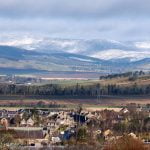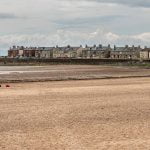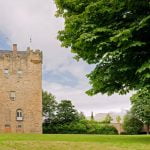The Five Minutes Spare Guide to Montrose
The seaside town in Angus with the name that sounds like someone’s 80 year old grandad.
Montrose is situated on the coastline of Angus, a densely populated area of Scotland known for its East-Coast accent and some stunning scenery. Montrose is a bit of an island town, situated between bridges. It’s the kind of place you go to visit and never leave again.
As usual, we are taking the Five Minutes Spare tour of this wondrous town, to see if it’s any good as a holiday destination. We already know it is, so let’s get to the convincing.
Early History of Montrose
We found an early history of Montrose that we could barely believe. Montrose is situated in a basin, and the Montrose Basin Heritage Society has put together an archaeological timeline of the Montrose area.
The land on which Montrose sits formed 4400 million years ago in the Precambrian era. Around 495 million years ago, during the Ordovician era, there was a huge ocean between North America, Scotland, and Europe. Old Red sandstone shows that geology formed in the Montrose area during the Devonian period. These calculations put the physical age of the earth beneath Montrose residents’ feet at 417 million years. That’s cool.
Moving forward to when we pesky people started to show up. There were people in the area in the Mesolithic Stone Age, around 8000 BC. These people were hunters and gatherers and fisher people. In 5000 BC a tsunami caused a huge tidal wave to hit the coast of Scotland and bring some of Norway’s shore with it. People returned by 3500 BC for the Neolithic Stone Age. They started to experiment with agriculture. Communal monuments discovered dated to this time.
We might not be able to tell you exactly when a town formed here, but we can tell you that during the Bronze Age, Maryton law Barrow was in use. Ring ditches were built at Old Montrose around this time. Archaeologists also discovered arrowheads and a sword dating to this period nearby. The timeline records discovery of gold jewellery north of the town.
Archaeologists unearthed a Roman naval camp near Gilrivie. At the small fishing village of Usan to the south, locals found gold Roman artefacts. The Romans which landed here were above the lines of defence. We bet they had a good laugh. History records a church on Rossie Islands from 500 AD. By 570 AD the chapel at Boddin Point existed but is now ruined. Boddin Point is still an amazing experience. Visit and take your jacket.
The Norse traded here, and the Vikings raided here. As a rule of thumb, they didn’t want to raid here. The plump lands were to the south. The Danes came to Britain on the hunt for easy land. They didn’t find it in Scotland.
Thanes and Mormaers were in charge in Montrose in the 10/11th centuries. Their reign ended under King Malcolm II in 1034. After that, we move into the Middle Ages.
Montrose During the Middle Ages
In Scots Gaelic, Montrose means the burn of the mossy point. It is a seaport situated between two arms of land. Montrose is a ferry port about 76 miles away from Edinburgh. Some sources maintain that the original name of this town was Celurca[i]. The Danes arrived in the 10th century when they found the estuary a convenient place to anchor their boats. They were thought to be 980 inhabitants of Montrose at that time, all of whom history records as massacred.
By the 12th century, King Malcolm IV had found mills and salt pans in the area. The castle was built in 1198 and the town was burned by invaders in 1244. In 1296, the Burgesses or leaders of Montrose, went down to Berwick to see King Edward I to take the oath of allegiance. Edward I visited Montrose from the 7th to the 12th of July 1296.
Legend holds that Lord James Douglas departed from Montrose in Spring 1330. His mission was to fulfil the last orders given by King Robert the Bruce. The King wanted his heart carried to Jerusalem and deposited in the holy sepulchre, as was a trend among the holy nobility of the time.
The English naval fleet made an attack in 1548 along the Montrose coast. The landing parties were beaten back by the inhabitants, led by Lord Erskine. There is a lot of Reformation history in the area. A local man named George Wishart taught the Greek Testament so extensively that the Bishop of Brechin summoned him on a charge of heresy in 1538. He was denounced a rebel and declared a fugitive in 1559 by the Catholic Church. So, Montrose was a haven for heretics. Nice.
One of the Crawford clan was given a grant by James the third in 1488. The castle seemed to be in ruin at this point. The Marquis of Montrose was born in the old town. He led a party of men against Alexander Irvin of Dun and 1644. Alexander was slain. There is a whole story in the Scots tongue on the Scottish Places page, which goes into this in more depth. The Marquess of Montrose was like Bruce and Wallace in reputation. Montrose fought for the Royalists and for his king and the Stuart monarchs on the same side as the notorious Campbell clan[ii]. He is not remembered fondly by the Scottish people.
During the same period of history, the Burgesses of the town appealed to the Duke of Montrose for protection, because the Lords of Dun kept ransacking their properties. James the 4th of Scotland intervened to settle the matter, but the duke failed in his responsibilities.
Let’s pause here to reflect on some fun facts about Montrose before we move on to more modern history.
Fun Trivia About Montrose
When we embark on a fresh travel guide, we like to ensure that we have gathered the gossip to a suitable degree. Here are all the fun facts we could find out about the town of Montrose in Angus, in Scotland. There might be a few facts in there that aren’t fun, but at least it will be interesting to find out.
- The first Duke of Montrose was in 1488, which should give some indication as to the age of the aristocracy in the area.
- Edward, the first bought 30,000 of his men to the town in 1296 and stayed at Munro’s Castle for three nights. It is said that he publicly humiliated John de Baliol, the Scottish king, by stripping him of his royalty and status. poor show, Edward 1st.
- There was a convent and Montrose, but nobody knows where it was.
- A fire levelled the entire town in 1244.
- The Danes sacked Montrose in 980, but it is said that Kenneth III repeated this in the 10th century.
- The town’s motto is “The sea enriches, the rose adorns.” The rose part comes from the town’s name – Mount of Roses – or Montrose.
That’s quite enough chitter chatter for one article. Let’s get to modern history before we run out of space.
The Industrial Revolution
There wasn’t as big an industrial revolution in Scotland as there was in England. The farther north you are away from the capital city, the less change residents saw.
Montrose became an official port in the 1700s, right around the time when shipbuilding started to reach empirical status in Scotland. Merchant families owned much of the land and much of Montrose Town. You can see their marks in statues, architecture, and int named streets like America Street, Baltic Street, and India Street. Let us never forget that many of the Scots merchant families dealt in goods produced by slaves in the Americas. It is important that we acknowledge that the early wealth that boosted or Industrial growth in Scotland came from the slave trade, and don’t you go thinking England wasn’t just as bad, either.
The 1715 Jacobite Rebellion passed through here in 1716, when the Old Pretender was here. He sailed into his exile in France from this port. Bonnie Prince Charlie came next, and a naval battle hit the shores here in 1746. Montrose fell into a somewhat dodgy repute at that time. It became a smuggling centre throughout the early 19th century. The long beaches and quick tides combine with low sands to make ideal grounds for illegal deals. In 1750, the population was 4,248 people. By the end of the century, it was over 5k.
Let us also remember the lunatic asylum that stood here in 1781. It moved in 1858 but think of all the horrific work that took place here at that time. It eventually developed into Sunnyside Royal Hospital in the 60s. 1785 saw a library added, but you could only use it if you had male genitalia.
The first modern aerodrome was built in Montrose in 1913, just in time for WWI.
Modern Day Montrose
Many of the young men of Montrose died in foreign shores during both wars. The local church holds a memorial board that records 214 deaths in WWI. During WWII, the RAF was stationed here at the Montrose Air Station. Bombing raids hit occasionally but they were largely too far from London to be a problem. Children from Dundee were evacuated here. There is a statue of a Norwegian St Bernard dog who acted as a minesweeper in WWII for the Royal Norwegian Navy. The dog died in 1944, prompting schools in Montrose to close, with 800 children attending his funeral.
In the roaring 20’s a slew of politicians, artists, and poets were born in the area. It began the inter-war renaissance period of reflection.
Modern Montrose has been slightly updated. It has a flashy harbour, some good shopping, and some nice places to eat. We can’t continue for now. The dog story got to us. Let’s move on to the famous folk from Montrose and try to forget that his captain registered him as a crew member.
Famous People from Montrose
Asides from the dog, there are a few famous people to have come from Montrose over the hundreds of generations. Here are some you may know:
- Poet Helen Cruikshank
- Early botanist Robert Brown
- Alexander Christie, a wealthy merchant.
- Let’s not forget the Marquess of Montrose
- And Scottish author Sir James Barrie
OK, not an astonishing list, but that’s fine. The scenery is what sells it in Montrose. With that in mind, here are the best places to see while you are there.
Top Montrose Attraction
This is the section you have all been waiting for – where we tell you the best bits about Montrose. Buckle up, it might be northern but its right in the heart of the fun.
Historic Sights and Landmarks
Boddin Point can be found at the northern end of Lunan Bay, a beautiful beach area. You’ll find it three miles south of Montrose proper, on a spur of rock that oversees the ocean like a seat. It’s a gorgeous viewpoint and a perfect sun trap on the few days of the year the big burning thing in the sky makes an appearance. Boddin itself is nothing more than a few buildings, but the view… it’s worth it.
Montrose Beach is an attraction on its own. Try to stay away from the mud traps at low tide. The part immediately next to the town seems to be safe enough. There is a lighthouse at the far end that you can visit for Instagram photos. It is this beach that has made Angus and Montrose a popular destination for lowland holidaymakers over the years.
Go and see the historic House of Dun. This is where the Montrose Burgesses always got bullied from. The Duns built this house in the Georgian period, and it is a true architectural marvel. It is run by the National Trust for Scotland so do go and spend lots of money. They do a great job preserving these places. Nowadays it is a garden estate, so take a tour and enjoy the gardens and history.
Galleries and Museums
Montrose Air Station Heritage Centre has all the detailed history of the air space here. It details the aerodrome and the RAF occupation. There are lots of old planes here to look at, including an old spitfire. They like to show the human side of the war front that was fought from Montrose Air Station. It has artefacts, photographs and memorabilia that make for an entertaining day out. Everyone loves a spitfire.
Stop into the Montrose Museum and Art Gallery if you want to appreciate fine art and history. They frequently change exhibits, so you get a full flavour of the culture. The museum was set up by the Antiquarian Society in 1841 and still thrives to this day. If you think you have ancestry in Montrose. Check here for further information. They have information on the Jacobite Uprising, the Marquis of Montrose, and they do a better job of not butchering the history than we might. Er. We try out best.
Outdoor Attractions
Lunan Bay is where the Vikings landed back in the 10th century. It’s not next door, but it is just around the corner from the Fishing Town of Usan and Boddin Point. This is the beach. If you want to go on a day trip in the good weather and stay within striking distance of Montrose, this is where you go to do it. There are no mudflats here, just sand. It’s a straight drive along the coast. There are caves at the very far end of it.
The Montrose Basin Visitor’s Centre is a favourite attraction here. This wildlife centre is an area of preservation and conservation, filled with rare birds and stunning Scottish scenery. They have a visitors centre, so you can learn about what you are seeing. A large portion of the basin is tidal mudflat. This is like a salt flat but dirtier. IT’s lethal for boats when the tide is low, and the high tide rushes in at between 4 and 6 miles an hour. You don’t want to be caught out in it when the shift happens. That’s why you stay near the shore. To be fair, you wouldn’t get far in the mud, anyway. The birds love it. There are over 100,000 migratory birds that pass through here, annually. Again, the Scottish Wildlife Trust do phenomenal work in protecting these places so please do stop by.
Montrose is on the edge of the St Cyrus Nature Reserve. St. Cyrus beach is a favourite in the area. If Lunan Bay is too far or too busy, then St Cyrus holds a beautiful cove. We did mention Usan earlier but there’s nothing there either except three or four houses. Don’t invade them, they are not equipped, and the shoreline is hard rock.
St Cyrus nature reserve has a graveyard with a grave to Beattie the Poet. The land features sand dunes that harbour various species of animal and grasses and whatnot. There is a patch of forest farther inland, but it’s mostly the dunes that are the main event.
Sports and Recreation
There’s a lovely little fruit farm named the Charleton Fruit Farm in the area. Kids love it due to the wooden playground. There’s fruit picking, pumpkin hunting, and all the usual attractions aimed at the little ones. They have a family restaurant and an actual play castle for the little ones to enjoy. You can shop, explore, stay over, the sky is the limit. It’s a beautiful piece of land in the summer.
There is a Montrose Golf Links experience and the Royal Montrose Mercantile Golf Club for you to choose from in this area. If you head north, you’re not so far away from the famous courses.
Montrose FC is the local football club. They are currently playing in Scottish League 1. They have a women’s club, too. They play at Links Park in Montrose; it’s a reasonably sized stadium and you can’t miss it.
Shopping and Retail
Honestly? When you get this far into Angus, the retail parks start to taper off and you are left with wholesome family-run boutique stores. There are a few clothing stores, some quaint cafes, and the kind of ancient Scottish High Street that sometimes jams up because there’s a bottleneck at the end of the main street that’s only big enough for a one-horse cart. This is probably the most accurate description of Montrose high street on the internet.
Other Notable Attractions
We may be getting low on the ground of things to do inside of Montrose this far down the list, but that doesn’t mean the excitement is over. You can head out into Fife, down to Edinburgh, or north to the Southern Highlands of Scotland to enjoy these other attractions:
- Visit the Langley Park and Gardens in town. They have a gorgeous wildflower meadow. It’s a walled garden, so it’s peaceful.
- Dunninald Castle and Gardens are outside of town.
- Go see this wee dog statue and have a good old greet.
But whatever you do, remember Montrose fondly.
How to get to Montrose?
Now you will need to know how to get there. We are notoriously bad at directions but follow these loose ones and ask someone when you’re close.
By Road
Head north out of Edinburgh and stick to the coast for a gorgeous drive. Montrose is after Arbroath but stop at Lunan Bay to the south there on the way past.
By Rail
Look for Montrose Station, owned by the infamous ScotRail.
By Air
You should head for Edinburgh Airport although Aberdeen is acceptable.
By Sea
Montrose has a lovely little harbour.
Got Five Minutes?
Are you still up for some entertainment? Did this travel guide to Montrose not quite hit the sweet spot? Head over to our Facebook page and follow us for updates or browse through hour other travel guides on our website. It’ll only take five minutes and they might lead you to your next adventure.
[i] https://www.scottish-places.info/towns/townhistory400.html
[ii] https://www.scotland.org.uk/history/earl-montrose





